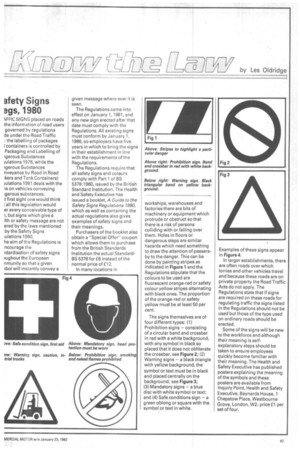afety Signs egs, 1980
Page 63

If you've noticed an error in this article please click here to report it so we can fix it.
by Les Oldridge
kFFIC SIGNS placed on roads the information of road users governed by regulations de under the Road Traffic : the labelling of packages I containers is controlled by Packaging and Labelling of 1gerous Substances ;illations 1978, while the 1gerous Substances nveyance by Road in Road ikers and Tank Containers) Kilations 1981 deals with the is on vehicles conveying igerous substances.
.t first sight one would think t all this legislation would er every conceivable type of 1, but signs which give a Ith or safety message are not ered by the laws mentioned by the Safety Signs iulations 1980.
he aim of the Regulations is ncou rage the idardisation of safety signs )ughout the European nmunity so that a given ibol will instantly convey a given message where ever it is seen.
The Regulations came into effect on January 1, 1981, and any new sign erected after that date must comply with the Regulations. All existing signs must conform by January 1, 1986, so employers have five years in which to bring the signs in their establishment in line with the requirements of the Regulations.
The Regulations require that all safety signs and colcturs comply with Part 1 of BS 5378:1980, issued by the British Standard Institution. The Health and Safety Executive has
issued a booklet, A Guide to the Safety Signs Regulations 1980, which as well as containing the actual regulations also gives examples of safety signs and their meanings.
Purchasers of the booklet also obtain a "Special Offer" coupon which allows them to purchase from the British Standards Institution the actual StandardBS 5378 for £6 instead of the normal price of £12.
In many locations in workships, warehouses and factories there are bits of machinery or equipment which protrude or obstruct so that there is a risk of persons colliding with or falling over them. Holes in floors or dangerous steps are similar hazards which need something to draw the attention of passersby to the danger. This can be done by painting stripes as indicated in Figure 1 and the Regulations stipulate that the colours to be used are fluorescent orange-red or safety colour yellow stripes alternating with black ones. The proportion of the orange-red or safety yellow must be at least 50 per cent.
The signs themselves are of four different types: (1) Prohibition signs — consisting of a circular band and crossbar in red with a white background, with any symbol in black so placed that it does not obliterate the crossbar, see Figure 2; (2) Warning signs — a black triangle with yellow background, the symbol or text must be in black and placed centrally on the background; see Figure 3; (3) Mandatory signs — a blue disc with white symbol or text; and (4) Safe conditions sign — a green oblong or square with the symbol or text in white. Examples of these signs appear in Figure 4.
In larger establishments, there are often roads over which lorries and other vehicles travel and because these roads are on private property the Road Traffic Acts do not apply. The Regulations state that if signs are required on these roads for regulating traffic the signs listed in the Regulations should not be used but those of the type used on ordinary roads should be erected.
Some of the signs will be new to the workforce and although their meaning is selfexplanatory steps should be taken to ensure employees quickly become familiar with their meaning. The Health and Safety Executive has published posters explaining the meaning of the symbols and these posters are available from Inquiry Point, Health and Safety Executive, Baynards House, 1 Chepstow Place, Westbourne Grove, London, W2; price El per set of four.




































































